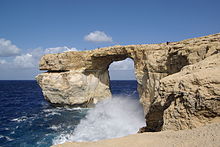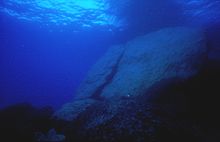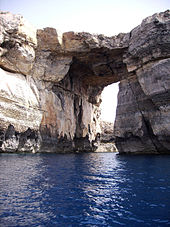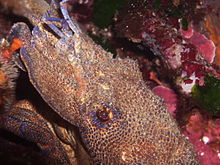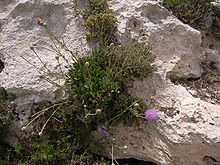Azure Window
The Azure Window ( Maltese Tieqa Żerqa , German Blue Window ) was a rock gate created by environmental influences in the west of the Maltese island of Gozo on the coast in front of the village of San Lawrenz . It was about 100 meters long and 20 meters high. On March 8, 2017, the rock gate collapsed completely during a storm.
Emergence
The rock formations were formed several million years ago. The archway and the surrounding rocky coast are made of coral and globigerin limestone . The Azure Window and the upstream Blue Hole were formed by the collapse of two large caves . The entire cliff of the island represents the last part of a former land bridge between Europe and Africa , which was interrupted about 13,000 years ago at the end of the Worm Ice Age. At that time the vegetation consisted of mixed and deciduous forest and thus corresponded to that which prevails in today's Central Europe. The water level varied greatly in different geological ages. This can be seen from the fossil remains of the surrounding cliffs and in the immediate vicinity of the Azure Window. In the area around the Azure Window, fossils of old seagrass meadows can be viewed.
However, the rock formation of the Azure Window itself did not form until the 19th century, according to geologists.
Erosion and decay
The Azure Window was permanently exposed to the sometimes very strong environmental influences such as wind and violent waves . The effects could be seen almost every year by enlarging the archway. Older postcards and motifs from the 1960s and 1970s show an archway with a thicker ceiling. The sometimes very large fragments are particularly evident under water. The northwest wind ( mistral ) that prevails throughout the year has a very strong effect on the erosion of the cliffs.
Since the partial collapse in April 2012, entering the archway has been prohibited. However, this ban was ignored so often that entering it became a criminal offense in January 2017. On March 8, 2017, the rock formation including most of the sea-side pillar collapsed during a storm. People were not harmed.
environment
The Azure Window and the entire Dwejra Point area are declared a nature reserve. Thereby gained Dwejra Point status Special Area of Conservation (SAC) ( Special Area of Conservation (SAC) ). The project was mainly funded by the EU. The total cost of the project was € 321,000 , with the European Union contributing € 211,000. The rest was financed by Nature Trust Malta and the MEPA (Malta Environment and Planning Authority). The project's goals had not yet been fully achieved at the end of 2016.
There are still a few illegal harpooners in the park , and inshore fishing is also not yet fully controlled. In 2010, part of the HBO series Game of Thrones was filmed in close proximity to the Azure Window. This caused damage to fossil seagrass meadows on which a film set with sand and a tent village was piled up. A court subsequently sentenced the Maltese coordinator and subcontractor of the filming to pay € 36,500. The sum was used to clean the area and repair the damage. The strong tourist rush also has a negative effect on the vegetation and the fossil animal and plant finds.
Marine life
The sea drops abruptly to depths beyond 60 meters at the rear of the Azure Window. The large fragments of the archway and the surrounding cliffs offer hiding places for a variety of marine animals. Due to the countless crevices and rocks there are many lobsters and slipper crabs . In addition to the animals and life forms that are common on the coast, there are also pelagic representatives . Typical representatives are species such as gold welts , mermaids , monk fish and octopus.
The European parrotfish , which came from the Atlantic to the central Mediterranean, can often be seen here. It is not as strongly represented on most of the other Mediterranean coasts as it is around the Maltese archipelago. The large grouper ( Serranus gigas ) has not been as common in recent years as it was a few years ago. On the back of the Azure Window are pelagic species such as the great amber jack ( Seriola dumerili ), barracudas and small tuna . In the lower animals many large calcareous tube worms can be found, the size of which surpasses tropical representatives of the species. The steep walls are overgrown with colorful crusty anemones in many places . Red calcareous algae and sponges can often be found.
vegetation
Due to the lack of nutrient-rich soils, the vegetation around the Azure Window is extremely sparse, plus the influence of the mistral and the resulting spray . This means that only a few, resistant plants grow in the immediate vicinity. On the way down from San Lawrenz, there are large agaves ( Agave americana ). Quite often the caper plant ( Capparis spinosa ) found in sunny sheltered niches, occasionally comes the Nice stonecrop ( Sedum sediforme before) that survives even in rocky, barren soil.
The "national plant of Malta", Cheirolophus crassifolius, is a specialty . This endangered plant can only be found in Malta, Gozo and the Fungus Rock .
tourism
The Azure Window was Gozo's main tourist attraction until March 8, 2017. It was particularly popular with day tourists from Malta. Due to the large number of visitors, there was an increased effort in waste disposal and an increased burden on the area.
The local fishermen organize boat trips from the nearby Inland Sea through the Inland Sea Tunnel . This is an important source of sideline income for the fishermen. Local traders offer various goods and refreshments in the vicinity.
Due to its location on the west side of the island, the Azure Window offered an impressive backdrop for sunsets.
Surroundings
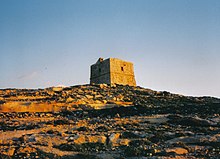
In the immediate vicinity of the Azure Window is Fungus Rock , a large rock in the ocean that is home to several endemic species of flora and fauna.
There is a small church between the Azure Window and the Inland Sea.
A little higher is an old watchtower of the Order of St. John . The tower, known as the Dwejra Tower , was completed in 1652 during the reign of Grand Master Jean de Lascaris-Castellar . The tower was supposed to monitor a stretch of coast that was suitable for a landing by enemy troops or by corsairs and alert the garrison in Victoria . For this purpose, the tower was erected within sight of other towers. The alarm was triggered during the day by shooting a small cannon or musket, at night by lighting a beacon. Like the other Lascaris Towers , the Dwejra Tower was only suitable for defense to a limited extent, as heavy weapons could not be placed due to the construction.
literature
- Hans E. Latzke: ADAC Travel Guide Plus Malta, Malta, Cozo, Comino, churches, palaces, temples, museums, beaches, festivals, cafes and bars, hotels, restaurants . ADAC at Travel House Media, Munich 2115, ISBN 978-3-95689-120-5 / ISBN 978-3-89905-887-1 .
- Lawson Wood: Sea Fishes and Invertebrates of the Maltese Islands and the Mediterranean Sea, Bloomsbury, London 2015, ISBN 978-1-472-92178-9 .
- Hans E. Latzke: DuMont travel paperback Malta with Gozo and Comino . 3rd edition, DuMond, Ostfildern 2004, ISBN 978-3-7701-5972-7 .
- Ernle Bradford: The shield of Europe - the fight of the Knights of Malta against the Turks in 1565. Wundrelich, Tübingen 1965; Universitas, Berlin 1976; Ullstein Frankfurt 1999, ISBN 3-548-34912-9 .
- Werner Lips: Malta, Gozo, Comino . Reise-Know-How-Verlag Rump, Bielefeld - Brackwede 1999, ISBN 3-89416-659-2 .
- Guido G. Lanfranco: Il-Hut Madwar Malta. The Fish Around Malta , Allied Publications, Valletta 1993, 1999, ISBN 978-99909-3-146-4 , Maltese and English.
- Heinz Gstrein : Malta, with Gozo and Comino (= Walter travel guide ). Herder, Freiburg im Breisgau a. a. 1992, ISBN 978-3-451-22758-5 .
- Claus Valentin: Fascinating underwater world of the Mediterranean , drawings: Rosella Faleni, Hartmut Sönnichsen, Parey, Hamburg / Pacini, Piza 1986, 1990, ISBN 3-490-12018-3 .
Web links
- Dwejra rock surface damaged, but biodiversity not impacted , January 2011. (Details of the damage during the filming)
- Sights and culture in Gozo
- Beaches and the tower
Individual evidence
- ^ Watch: The Azure Window is lost and gone forever. Times of Malta , March 8, 2017, accessed March 8, 2017 .
- ↑ Stone Age: Ice Age , accessed on February 21, 2013.
- ^ Joseph Caruana: Geology and Geomorphology of the Djeira Bay. Retrieved January 4, 2020 .
- ^ Allied Newspapers Ltd: The Azure Window: lost and gone forever . In: Times of Malta . ( timesofmalta.com [accessed March 8, 2017]).
- ↑ Dwejra - A Coastal Nature Park (pdf).
- ↑ Dwejra sand saga cost local production company € 36,500. , published April 25, 2011 on www.timesofmalta.com.
- ↑ Claus Valentin: Fascinating Underwater World of the Mediterranean , 1986.
- ↑ Guido G. Lanfranco: The Fish Around Malta , 1993, p. 43, plate 28.
- ^ Claus Valentin: Fascinating Underwater World of the Mediterranean , 1986, p. 137.
- ^ Sea Fishes and Invertebrates of the Maltese Islands and the Mediterranean Sea, Lawson Wood, 2002, p. 100
- ↑ a b Mgarr ix-Xini Tower, Gozo on Military Architecture (by Stephen C. Spiteri , English)
- ↑ Dín l-Art Ħelwa, Dwejra Tower, Gozo (English)
- ↑ Stephen C. Spiteri: Naxxar and its fortifications on Military Architecture ( Memento from January 16, 2016 in the Internet Archive ) (English)
- ↑ Stephen C. Spiteri: Madliena Tower - Malta's 'Martello' Tower on Military Architecture (English)
Coordinates: 36 ° 3 ′ 14 ″ N , 14 ° 11 ′ 19 ″ E
